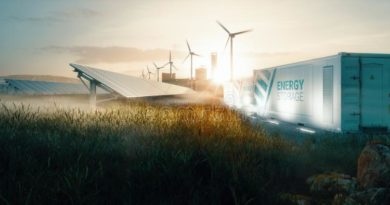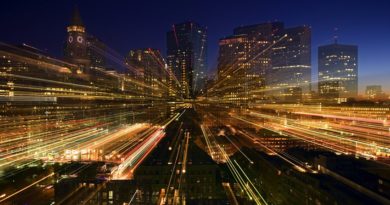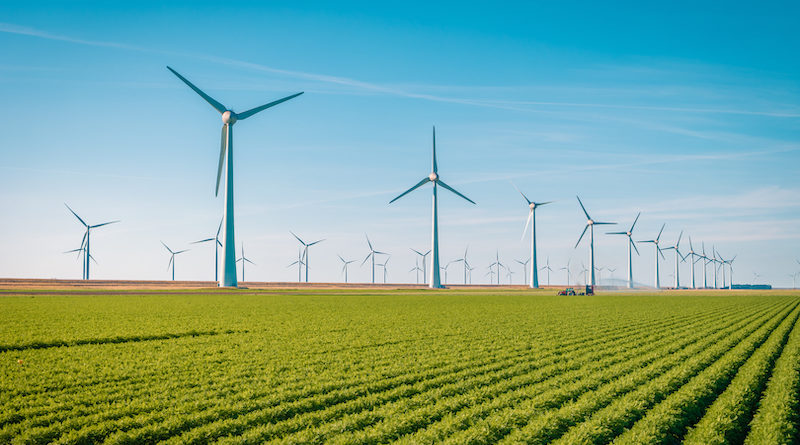
Clean Hydrogen as A Major Enabler for Making Carbon-Free Ammonia and Fertilizers
“As one of the biggest producers and users of hydrogen Europe, fertilizer producers have all it takes to be frontrunners in scaling up the production of renewable hydrogen. Going beyond fertilizers, low-carbon ammonia could be the fuel of the future for maritime shipping and a viable energy storage solution”.
The nitrogen fertilizer industry is main hydrogen producer
With a share of about 50%, the ammonia industry is today the biggest producer and user of hydrogen in Europe. Unlike hydrogen, ammonia is already being produced and transported worldwide in huge quantities (180 million tonnes annually are produced and 18 million tonnes are transported) as it is the basis of many chemicals and very importantly the starting phase for producing fertilizers (80% of the demand).
Today, the hydrogen for making ammonia is obtained by cracking at high pressures and temperatures the natural gas with the help of steam. This splitting process (steam methane reforming, SMR) generates significant quantities of CO₂.
A low-carbon route involves underground storage of at least part of this CO and gives what is commonly called blue ammonia (SMR + carbon capture and storage, CCS). Alternatively, when ammonia is produced from green electricity and water via electrolysis, or other sources of low carbon hydrogen, the process requires only air.
Green ammonia and low carbon food in 2050?
The world is today completely reliant on ammonia. Indeed, ammonia as a key component of mineral fertilizers contributes to half of the world’s food production. Globally, the fertilizer industry is responsible for about 1.1% of annual carbon emissions due to using fossil energy as feedstock (approximately 80% of production uses natural gas, while coal accounts for approximately 15%).
By making a business case for low-carbon ammonia, we will at the same time help decarbonize food production and take a big step towards a hydrogen economy. By 2050, under the right conditions, ammonia production could be based on decarbonised sources of energy, using alternatives sources of hydrogen and electrolysis based on renewable energy.
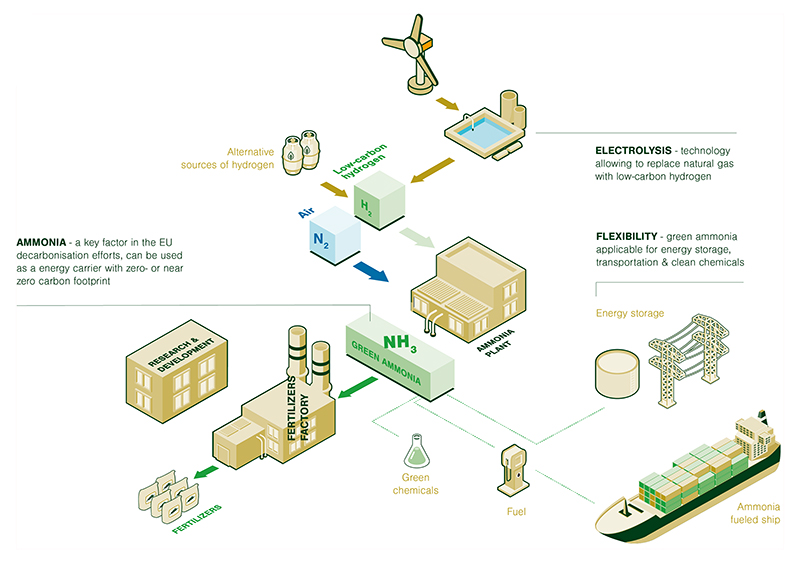
Moving forward
Several big ammonia producers have announced projects to make hydrogen from water using renewable energy. Here are few examples:
- In Spain, Iberdrola together with the fertilizer producer Fertiberia are behind a project coming on-stream next year where solar panels will produce energy for a 20 MW electrolyser. This electrolyser will produce some 5 % or the hydrogen needed for ammonia production in the fertilizer plant. By 2027, it plans to install 800 MW of green hydrogen production capacity.
- In the Netherlands, a project has been announced where Orsted will build a 100 MW electrolyser based on wind energy to deliver hydrogen to Yara fertilizer plant. These 100 MW can produce 10 % of the hydrogen needed to run one of the two ammonia units of the plant.
- In Norway, Yara recently announced plans to electrify its ammonia plant, thereby potentially removing 800,000 tonnes of CO2 per year, provided the required public co-funding and regulatory framework are in place.
- Lately, the biggest ammonia producer in the US, CF Industries and the Asian Renewable Energy Hub and Fortescue Metals Group in Australia, amongst others, have also announced plans to develop ammonia based on green hydrogen.
Ammonia – the workhorse of the hydrogen economy
Although it might seem a paradox, ammonia is a better hydrogen carrier than hydrogen itself. Storing and transporting hydrogen is a challenge as it is the smallest and lightest molecule in nature and it liquifies only at the extremely low temperature of – 253 degrees Celsius. Ammonia on the other hand, liquifies at -33 degrees Celsius and can be handled better, similarly to liquified natural gas.
Storing hydrogen under pressure is also possible but again, ammonia has three times the energy density of compressed hydrogen, and nine times that of Li-ion batteries, making it very attractive as a potential carbon-free energy carrier.
Therefore, when hydrogen is needed, in many applications it makes more economical sense to transform, transport and use it in the form of ammonia.
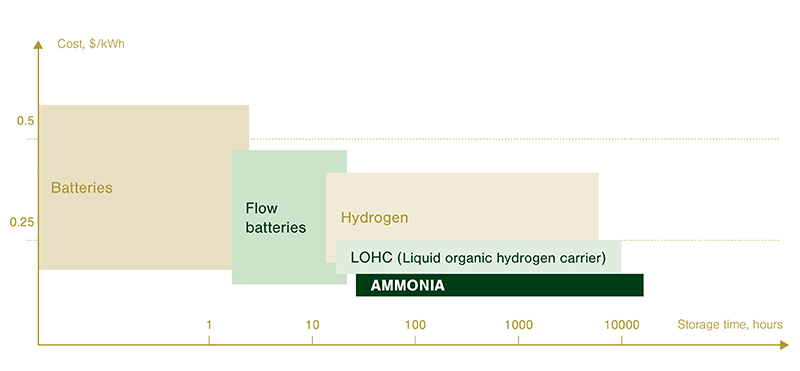
Beyond fertilisers – decarbonising other sectors
In practice, ammonia is the only carbon free fuel. As such, it brings the promise to decarbonise the maritime shipping sector reducing its emissions by 95% by 2035 and the demand could reach about 1 million tons ammonia per day (reference Lloyd’s Register Vessels 2030, how do we get there?).
Indeed, with limited modifications and technology improvements ammonia could be directly used in combustion engines of deep-sea vessels.
Global ammonia transportation and storage infrastructure already exists with a presence in 120 seaports globally.
The ammonia molecule is also probably one of the best alternatives for the mid/long-term storage of electricity as chemical energy. As such it can be used in buffering a renewables-based electricity system by transforming electricity into hydrogen/ammonia when renewable energy is abundant and cheap and burned to produce electricity when needed.
Big scale projects have been announced in Saudi Arabia and Australia where energy from solar panels will be transformed into ammonia via electrolysers, and this ammonia will then be used to transport the energy around the world.
The challenges ahead
In the EU, the fertilizer sector produces and consumes 3,1 million tonnes of hydrogen and is best placed to help upscale new technology in the most cost-effective way. Balancing EU’s climate ambitions with industrial competitiveness will be key to a successful implementation of this strategy. However, several barriers remain to gradually switch production from current SMR based hydrogen towards low-carbon routes.
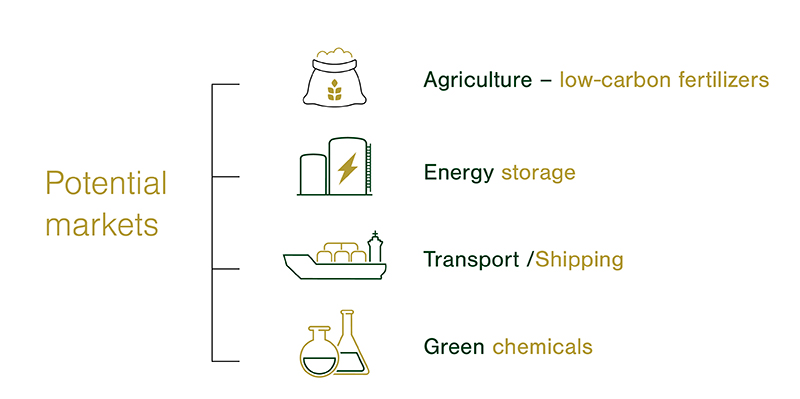
Abundant and competitively priced clean electricity to produce hydrogen is a pre-condition for green ammonia to become competitive and challenge the current production technology. Furthermore, as fertilizer plants with ammonia production are scattered all over Europe electricity and/or hydrogen transport infrastructure is a required for a balanced development.
The next challenge is making the business case. Today ammonia production based on green or low-carbon hydrogen cannot compete with production based on natural gas.
Public support for investment and operational cost is necessary now to get the ball rolling.
It also includes considering schemes such as the Carbon Border Adjustment Mechanism to help maintain a level playing field and prevent green ammonia being outcompeted by cheaper imported grey ammonia. With such measures in place, European fertilizer producers should gain the confidence and the economic room to invest in new technologies.
The third challenge is creating markets that reward low-carbon ammonia. In the future there will be at least two major markets for ammonia: fuel for deep-sea shipping and for nitrogen fertilizers.
We need to define and create certification schemes for green and low carbon ammonia and by extension fertilizers, so that farmers can make this a premium selling point the food chain.
Cooperation of all stakeholders is required, including the EU, Member States and regional authorities in supporting industries in rolling out new technologies, for example by providing financial incentives and partaking in development of regional hydrogen resources.


